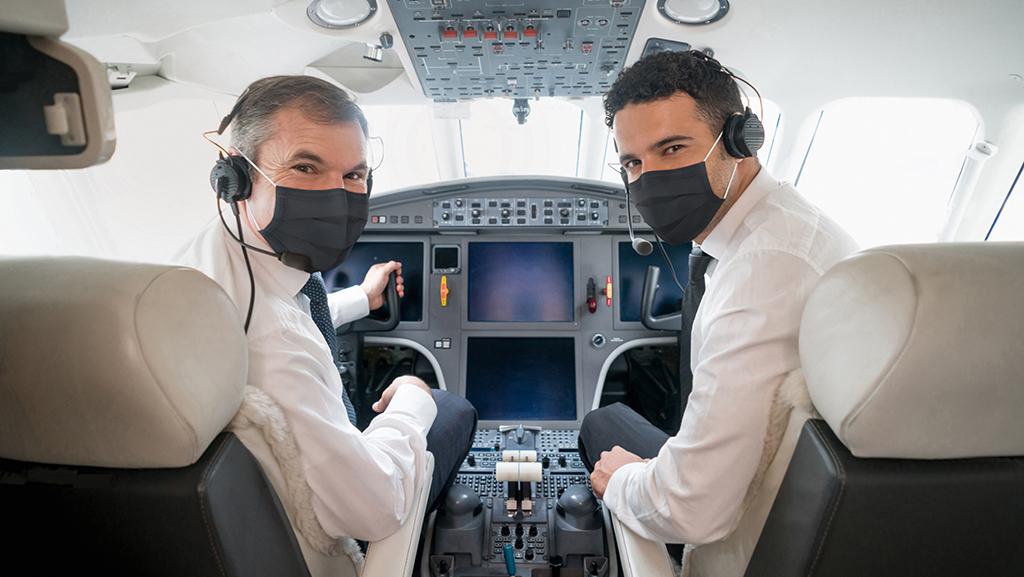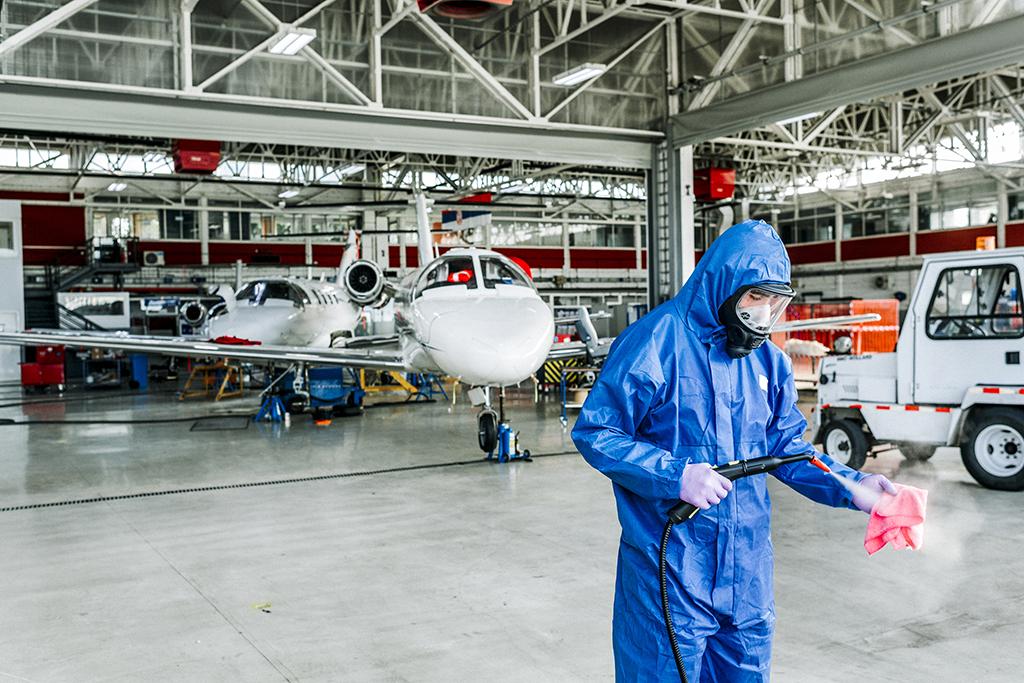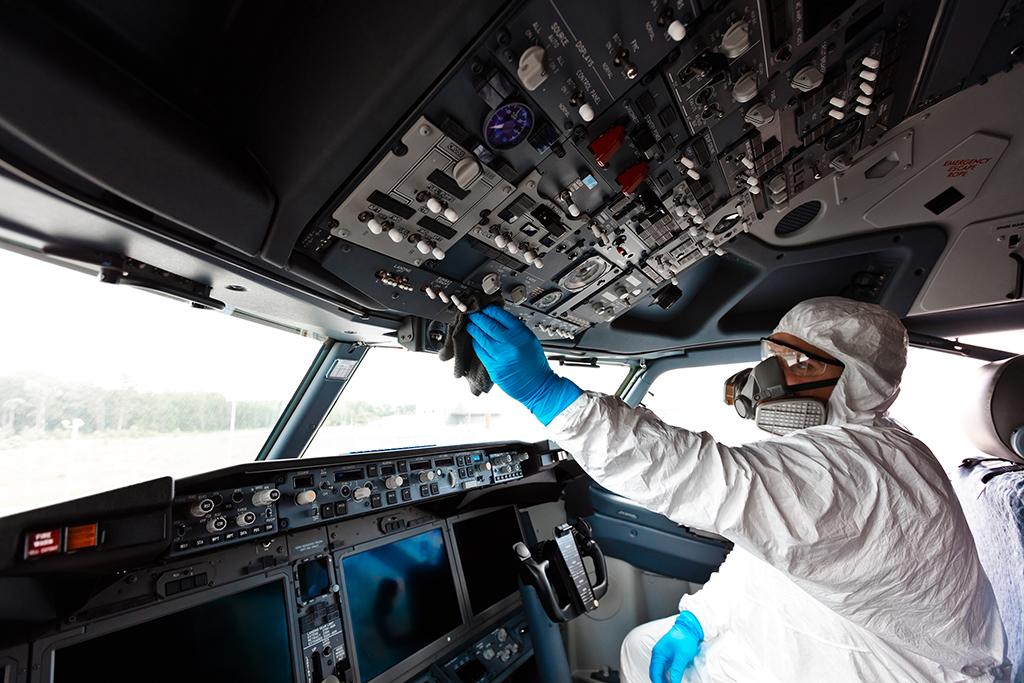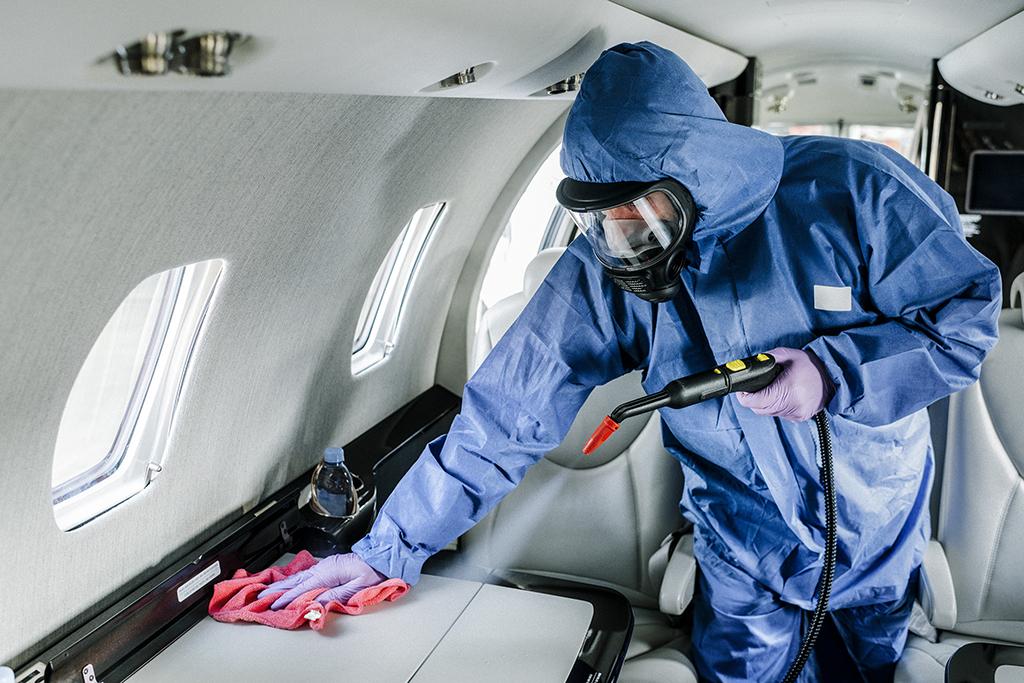Flying Petri Dish: Aircraft Can Accelerate The Spread Of Disease

As pilots, we regard aircraft as technological marvels, but infectious disease specialists and epidemiologists have quite a different view. To them the growing mobility of people via air transport has amplified the potential for rapid dissemination of disease. For confirmation we need only look at the current COVID-19 pandemic to understand the potential magnitude.
What is the actual risk of getting sick when traveling by air? Joseph Allen, an assistant professor at Harvard’s School of Public Health, notes many factors including time in terminals, hotels and security queues; changing time zones; and lack of sleep negatively impact a body’s immune system. Was your seat’s previous occupant a disease carrier?
And being seated at the very front of an aircraft does not shield crews from exposure. Consider what lurks within the oxygen mask or the composition and handling of what’s on the food tray.

The fact is aircraft cabins and cockpits are prime environments for disease. The four routes for the spread of microorganisms on an aircraft are contact, airborne, common vehicle and vector-borne.
Contact transmission involves direct body-to-body contact, or indirect in which a person comes into contact with a contaminated particle. As we have learned from COVID, diseases can be transmitted when an infected person sneezes, coughs or talks, propelling droplets that can remain suspended in the air for sufficient time periods and travel distances to infect others nearby.
Airborne transmission happens by aerosolization of an infectious agent from large droplets that have evaporated into smaller droplets (less than 5 microns) and disperse widely. Depending on environmental conditions, aerosolized droplets can remain suspected in the air for indefinite time periods.
According to Drs. Alexandra Mangili of the Division of Geographic Medicine and Infectious Diseases at Tufts Medical Center and Mark A. Gendreau of the Lahey Hospital and Medical Center, large droplet and airborne mechanisms probably represent the greatest risk for passengers within the aircraft cabin because of the high density and close proximity of those travelers. Documented cases of airborne infectious transmission aboard a commercial airliner include tuberculosis, severe acute respiratory syndrome (SARS), influenza and measles.
There are other methods that can make ourselves and our passengers sick. “Common vehicle transmission” is typically caused by microorganisms that are spread by food and water. Examples include salmonellosis and staphylococcus. Vector-borne transmission results from the spread of disease by insects and vermin. The most common example that is documented is malaria.
Cabin Air Transmission
The aircraft cabin is an enclosed environment that exposes passengers to hypobaric hypoxia, dry humidity and each other. The outside air passed through bleed valves into the aircraft’s ventilation system is sterile at cruising altitudes. Typical systems flow air into the cabin through the overhead, whereupon it circulates across the cabin and then exits near the cabin floor. Little front-to-back airflow occurs, which limits the spread of airborne particles throughout the space.

Business aviation crews and passengers tend to spend a lot of time on airliners. Consequently, it is worth knowing many of those aircraft recirculate 50% of the air delivered to the cabin for improved control of cabin circulation, humidity and fuel efficiency. This recirculated air usually passes through high-efficiency particulate air (HEPA) filters before delivery into the cabin. Normal airline cabin air-exchange rates vary from 15 to 20 changes per hour, compared with 12 changes per hour for a typical office building. Properly maintained HEPA filters remove dust, vapors, bacteria, fungi and viral particles.
Because the aircraft cabin is enclosed and flights can be hours long, there is the risk of a contagion among passengers. And while the risk is much greater for those sitting near a passenger with an illness, diseases spread through airborne routes can infect those sitting rows away.
Airborne transmission involves droplets exhaled by an infected person that are dispersed through the cabin and inhaled by others nearby. The dispersion depends in part upon the airflow as well as the force of the exhalation, with a coughing passenger spreading the infected droplets farther than when simply breathing or talking.
The swine flu epidemic in 2009 caused concern due to transmission among air travelers through direct contact, indirect contact, droplets and/or airborne routes. Epidemiologists determined that transmissions spread to passengers rows away from the infected person, thus indicating the potential for airborne spread.
SARS may seem like a distant memory, but it actually was our first experience this century with a coronavirus that was widely spread by air travelers. Post-incident evaluation of 40 flights carrying SARS-infected passengers has led epidemiologists to believe that the disease was spread by airborne small droplets. A “superspreading event” occurred on March 15, 2003, aboard a 3-hr. flight from Hong Kong to Beijing with 120 passengers aboard. The evidence shows 37 of those people showed symptoms of SARS after the flight. Laboratories were able to confirm SARS coronavirus infection in 16 passengers, while two were probables and four were reported to have the syndrome but could not be interviewed. Epidemiologists believe that more than 300 people were subsequently infected by these passengers.

 Jitendra K. Gupta Ph.D. of Purdue University’s School of Mechanical Engineering, Chao-Hsin Lin Ph.D. of the Environmental Control Systems Division of Boeing Commercial Airplanes and Qingyan Chen of Tianjin University’s School of Environmental Science and Engineering conducted a study on the risk of airborne infectious disease transmission in aircraft cabins. They evaluated a condition in which a passenger infected with the flu is sitting in the center of a twin-aisle, fully occupied airliner for 4 hr. Employing computational fluid dynamics, they computed the effects of small versus large droplets being trapped by masks of varying weave thickness, whether the infected person was gently coughing or sneezing, the inhalation differences among passengers, their proximity to the infected passenger, and the airflow differences within the cabin.
Jitendra K. Gupta Ph.D. of Purdue University’s School of Mechanical Engineering, Chao-Hsin Lin Ph.D. of the Environmental Control Systems Division of Boeing Commercial Airplanes and Qingyan Chen of Tianjin University’s School of Environmental Science and Engineering conducted a study on the risk of airborne infectious disease transmission in aircraft cabins. They evaluated a condition in which a passenger infected with the flu is sitting in the center of a twin-aisle, fully occupied airliner for 4 hr. Employing computational fluid dynamics, they computed the effects of small versus large droplets being trapped by masks of varying weave thickness, whether the infected person was gently coughing or sneezing, the inhalation differences among passengers, their proximity to the infected passenger, and the airflow differences within the cabin.
And their findings? Passengers seated near the infected person inhaled high doses of the influenza infectants. The airflow then caused droplets to move rearward and toward the window. Thus, the dose inhaled by passengers sitting at the window seat behind the sick passenger was high.
Simply breathing the ejected droplets doesn’t ensure that a passenger will become sick. The infection probability is proportional to the amount of influenza inhaled, and also depends on the strength of one’s immune system.
They also determined that N-95 respirator masks can provide a protection factor of 10. In other words, wearing such a mask would protect a passenger by reducing the amount of inhaled virus particles to one-tenth of that without a mask. If the infected passenger is also wearing a mask, the amount would be even lower.
Surface Contamination
Dangerous bacteria can survive for days on surfaces, particularly porous material such as armrests and seat-back pockets, along with tray tables, window shades and metal lavatory buttons. Kiril Vaglenov, a graduate student in Auburn University’s Department of Biological Sciences, helped lead researchers in a two-year study funded through the FAA’s Airliner Cabin Environmental Research Center to determine how long E. coli O157:H7 and methicillin-resistant staphylococcus aureus, or MRSA, would survive on commonly touched cabin surfaces. They even used simulated sweat and saliva since body fluids would affect the survivability and transmission (because of the pH) of a pathogen.
“Our data show that both of these bacteria can survive for days on these surfaces,” said Vaglenov. MRSA survived the longest—168 hr. —on material from the seat-back pocket, while E. coli lived for 96 hr. on the armrest material.
“The point of this study is not to be alarmist, but to point out to the airlines the importance of providing a sanitary environment for travelers,” said professor Jim Barbaree, director of the study and Vaglenov’s mentor. “We want to work with them to minimize the risks to human health.”
Consumption Considerations
Food or water-borne sicknesses manifested during flight can disable a person to the extent where a medical divert might be warranted. If this happens to a flight crewmember to the point of incapacitation, then the flight’s safety is compromised, or worse.
Dr. David G. Newman of the Australian Transport Safety Bureau (ATSB) conducted a study to investigate the prevalence, type, nature and significance of inflight medical conditions and incapacitation of civilian pilots Down Under.
Newman’s project reviewed the ATSB databases comprising 8,302 accidents, 95 serious incidents and 151,941 incidents. A “serious incident” is one in which an accident nearly occurred. There were 98 occurrences in which the pilot of an aircraft was incapacitated for medical or physiological reasons.
The study determined that a majority (21%) of inflight medical and incapacitation events were due to acute gastrointestinal illness, and usually food poisoning. This confirmed the findings of other international reports and pilot surveys that gastrointestinal illness is the most-common cause of pilot inflight incapacitation. According to Dr. Robin Wilkening of the Johns Hopkins School of Public Health, pilot surveys indicate acute gastroenteritis accounts for approximately 60% of incapacitation or impairment cases. And a review of the UK Civil Aviation Authority’s Mandatory Occurrence Report (MOR) database from 1990 to 1999 for all public transport operations found there were 127 incapacitation events, of which 68 (53%) were gastrointestinal.
These are significant findings for many reasons. Appropriate education programs and preventive strategies can help to reduce the risk of an acute gastrointestinal event. It is important crew meals are prepared to the highest possible hygiene standards and paired pilots receive different meals. However, the risk is not limited to inflight catering. As Newman points out, in many of the events studied, it was what the pilots ate and drank during layovers or in the preflight period that might have been responsible for the later illness.
Food- or water-borne infections can also occur to passengers, of course. Salmonella has been the most-reported food-borne incident on commercial airliners. A total of 15 incidents between 1947 and 1999 infected 4,000 passengers and resulted in seven deaths. During that time period there were also eight food-poisoning outbreaks caused by staphylococcus. One of the largest cases infected 57% of the passengers who were served a ham omelet on an international flight in 1975.
Cholera from a cold appetizer infected 47 people on a flight from London to Sydney via Singapore in 1972, killing one passenger. During a cholera epidemic in Latin America in 1992, 75 passengers were infected on a flight from Buenos Aires to Los Angeles via Lima. Ten passengers required hospitalization and one died.
Improvements in food handling and inspection and greater use of prepackaged frozen meals in recent years have likely contributed to minimizing the frequency and severity of food- and water-borne outbreaks.
Bad Bugs
Diseases spread by insects are common causes of sickness and death throughout the world. Insects such as mosquitoes can carry deadly diseases including malaria, dengue fever and yellow fever. Mosquitoes imported on aircraft have transmitted malaria to insect populations adjacent to airports. A total of 87 cases of “airport malaria” have been reported, 75 of which happened in Europe. Flies and cockroaches present the greatest hazard because of their feeding habits and the sites they visit. Insects can hide in the most inaccessible places onboard aircraft and may transfer organisms from their legs and bodies to food and equipment as they move around.
Under the Chicago Convention, which governs international civil aviation, a country could impose a “disinsection” requirement, which is the use of insecticide for insect and disease control, should it perceive a threat to its public health, agriculture or environment. In order to minimize the risk of importing disease-carrying rodents or insects or pests that might cause crop damage, some countries require cabin disinfection of inbound commercial aircraft in accordance with World Health Organization International Health Regulations. (The U.S. Department of Transportation’s “Aircraft Disinsection Requirements” page at bit.ly/USDOT_AircraftDisinsection contains a list of the countries.) Operators should ensure that they have adequate pest control measures in place to comply with a country’s entry requirements.
Disinfection is frequently accomplished by spraying the cabin with an aerosol before opening the cabin doors at the destination or by applying a residual solution to the aircraft interior that lasts for several months. It is recommended that aircraft traveling from countries with malaria and other vector-borne diseases utilize disinsecting measures. Some countries mandate them. Public health agencies and mosquito abatement districts surrounding international airports now have to be concerned about sampling for these exotic diseases and applying vector control to manage their outbreak.
Summary
The best prevention for the spread of illness is postponement of travel in any public transport by anyone with a contagious disease until the danger has passed.
Mangili and Gendreau said in their March 2005 article in the Lancet scientific journal (“Transmission of Infectious Diseases During Commercial Air Travel”), “SARS exemplifies the ever-present threat of new infectious diseases and the real potential for rapid spread made possible by the volume and speed of air travel. The distribution pattern of SARS transmission aboard the flight emphasizes the need to study airborne transmission patterns aboard commercial aircraft.”
The world’s economy was sent into a downward spiral in just a month by the outbreak of COVID-19. Nations and states, each acting out of self-interest, instituted various measures, often without coordinating with neighboring entities.
We need to make our businesses and our economy more resilient to these unexpected and deadly threats. COVID-19 will certainly not be the last pandemic the world will face. A harsh lesson from it is that the containment of this disease extracted a tremendous toll by causing mass unemployment and business bankruptcies.
The “new normal” needs to provide layers of protection against biohazards so that the spread of communicable diseases can be managed at low infection levels.
Fortunately, there are emerging technologies that offer effective means to kill pathogens in aircraft. Bio-tech companies are utilizing UV rays and ion-producing machines that are compatible with aircraft materials. Not only do these devices kill COVID-19, they also are effective against a wide range of bacteria and other viruses. In the short term, they offer an effective tool to confront COVID-19. In the long term, these devices could protect us against the next nasty flu.
Responsible businesses will recognize their obligation to provide the best possible protections for their employees and customers against these hidden dangers. We don’t want another near-collapse of the national and world economies. It is in all of our best interests to do our part.



